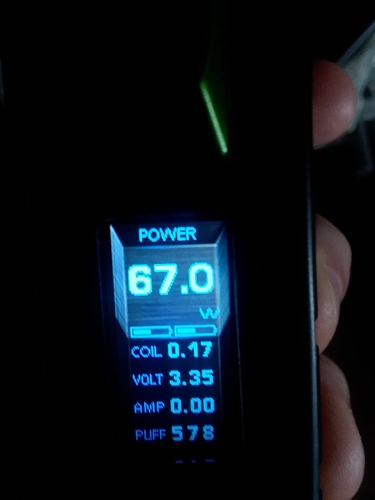Right. The batteries are series connected (doubling the maximum available battery Voltage potential). Those batteries (should, advisably) have the same maximum continuous discharge Current ratings (same make/model batteries).
(For a given physical coil-wicking setup built on the same deck), your best “gauge” looking back in time to previous practices is the Power in Watts (reflecting peak/average Temperatures previously preferred).
Working Backwards from “Load” to “Battery”:
Knowing the (Load) Watts, add a fraction of that amount ( < 1/20 ?) for Mod Power consumption, and from that sum of Powers (Load + Mod), calculate the common (maximum average) continuous total discharge Current flowing through the battery cell(s) at a fully-charged Voltage (4.2 Volts per cell, or any particular somewhat lower voltage perhaps more representative). The maximum continuous discharge Current rating of the batteries utilized should be at least 4 times (better yet, ~5 times) the multiple of the calculated Current (process described directly above), for best performance (minimizing “drooping”).
As long as the Mod in question (at the output-drive point) can generate sufficient Voltage corresponding to some (composite, net load) Current to dissipate N-Watts of Power in some (composite, net) Coil(s) Resistance, the Mod should be able to do it. The specified range of possible load Resistances reflects the electrical limits of the device.
Again, the “15 W” displayed is just an (arbitrary) number (generated from calculated Heat Flux) ! ![]()
Stainless Steel is lower Resistance than Kanthal A1/APM - which enables one to construct (feasible, in this case, single) coils [such as using ~5 turns (SS), as compared to using ~2 turns (KT), respectively).
.
For some semi-energetic “heavy-duty prior Nerditude”, some important “factors” are discussed here:
Summary:
The use of thicker wire gauges in order to achieve a lower total Coil(s) Resistance requires more Coil Power (Watts) in order to achieve the same 10%-90% Temperature Rise Time (of increases in the Temperature of the Coil/Wick Interface). As a result, the particular coil wire gauge that is used in creating a coil(s) determines a specific range of Coil Power (Watts) within which an “acceptably fast” 10%-90% Rise Time can be realized - with the required amount of Power (Watts) increasing with wire thickness. Maximizing (inner) Coil Surface Area while minimizing Coil Mass minimizes 10%-90% RT.

